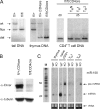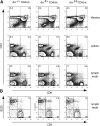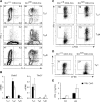Aberrant T cell differentiation in the absence of Dicer
- PMID: 16009718
- PMCID: PMC2212998
- DOI: 10.1084/jem.20050678
Aberrant T cell differentiation in the absence of Dicer
Abstract
Dicer is an RNaseIII-like enzyme that is required for generating short interfering RNAs and microRNAs. The latter have been implicated in regulating cell fate determination in invertebrates and vertebrates. To test the requirement for Dicer in cell-lineage decisions in a mammalian organism, we have generated a conditional allele of dicer-1 (dcr-1) in the mouse. Specific deletion of dcr-1 in the T cell lineage resulted in impaired T cell development and aberrant T helper cell differentiation and cytokine production. A severe block in peripheral CD8(+) T cell development was observed upon dcr-1 deletion in the thymus. However, Dicer-deficient CD4(+) T cells, although reduced in numbers, were viable and could be analyzed further. These cells were defective in microRNA processing, and upon stimulation they proliferated poorly and underwent increased apoptosis. Independent of their proliferation defect, Dicer-deficient helper T cells preferentially expressed interferon-gamma, the hallmark effector cytokine of the Th1 lineage.
Figures






References
-
- Mello, C.C., and D. Conte Jr. 2004. Revealing the world of RNA interference. Nature. 431:338–342. - PubMed
-
- Ambros, V. 2004. The functions of animal microRNAs. Nature. 431:350–355. - PubMed
-
- Lippman, Z., and R. Martienssen. 2004. The role of RNA interference in heterochromatic silencing. Nature. 431:364–370. - PubMed
-
- Meister, G., and T. Tuschl. 2004. Mechanisms of gene silencing by double-stranded RNA. Nature. 431:343–349. - PubMed
-
- Bartel, D.P. 2004. MicroRNAs: genomics, biogenesis, mechanism, and function. Cell. 116:281–297. - PubMed
Publication types
MeSH terms
Substances
Grants and funding
LinkOut - more resources
Full Text Sources
Other Literature Sources
Molecular Biology Databases
Research Materials

